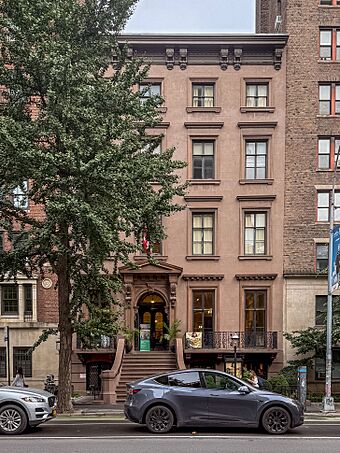Salmagundi Club facts for kids
|
Salmagundi Club
|
|

(2024)
|
|
| Location | 47 Fifth Avenue, New York, New York |
|---|---|
| Built | 1853 |
| Architectural style | Italianate |
| NRHP reference No. | 74001275 |
Quick facts for kids Significant dates |
|
| Added to NRHP | July 25, 1974 |
The Salmagundi Club is a special place for fine arts in New York City. It was started in 1871 in a neighborhood called Greenwich Village. Since 1917, it has been at 47 Fifth Avenue. In 2021, about 1,250 people were members of the club.
The club is a hub for fine arts. It brings together artists and people who love art. They hold art exhibitions, offer art classes, and host live art demonstrations. The club also has art auctions and many other fun events. It even helps with the United States Coast Guard Art Program (COGAP).
Contents
History of the Salmagundi Club
The Salmagundi Club began in 1871. It was first called the New York Sketch Class. Later, it became the New York Sketch Club. The club started in the studio of sculptor Jonathan Scott Hartley. This studio was on Broadway in Greenwich Village.
A group of artists, students, and friends met there. They were from the National Academy of Design. They gathered every Saturday evening.
How the Club Got Its Name
The club officially changed its name in January 1877. It became The Salmagundi Sketch Club. The name "Salmagundi" might come from a type of stew. This stew was served by the group from its earliest days. Another idea is that the name comes from Washington Irving's Salmagundi Papers.
Moving to a New Home
The club grew very quickly. It moved to several rented places over the years. These included locations on Fifth Avenue and West 22nd Street. It stayed at 14 West Twelfth Street for 22 years.
In April 1917, the club bought a new building. It was an Italianate-style brownstone townhouse. The building was built in 1853 and is located at 47 Fifth Avenue. The club paid $75,000 for it. They also added a two-story annex for an art gallery and a billiard room. This cost an extra $20,000.
A big party was held on February 5, 1918, to celebrate the new home. More than 500 people attended. In 1918, the club helped with a national effort. They created special paintings to train military gunners for World War I. The club provided the art supplies for these paintings.
Recognized as a Landmark
In 1969, the club's building was named a city landmark. This was done by the New York City Landmarks Preservation Commission. In 1975, it was added to the National Register of Historic Places. This means it is an important historical site.
Club Membership and Artists
For its first 100 years, the Salmagundi Club was only for men. However, artworks by women were still shown and praised. A separate club for women artists, the Pen and Brush Club, was formed nearby in 1894. The Salmagundi Club started allowing women to become members in 1973.
Famous Members of the Club
Many well-known artists have been members of the Salmagundi Club. Some of these include William Merritt Chase, Childe Hassam, Norman Rockwell, Augustus Saint-Gaudens, Louis Comfort Tiffany, and N.C. Wyeth.
The club has also had famous honorary members. These are people who are recognized for their achievements. Some honorary members were Winston Churchill and Al Hirschfeld.
The Club's Art Collection
The Salmagundi Club has a large art collection. It includes about 1,800 works of art. These pieces are from the 1840s to today. The collection features paintings, sculptures, and drawings. All the art is by past and present club members.
The collection grows through different ways. Some artworks are bought as prizes from exhibitions. Others are donated by artists or left to the club in wills. The art is displayed throughout the townhouse. It is rotated often, so there is always something new to see. The works are also shown in online exhibitions.
Special Mugs and Palettes
In 1894, the club held a special event to raise money for its library. Artist members decorated ceramic mugs. A club potter then fired these mugs. After a dinner, the finished mugs were auctioned off.
Many of these decorated mugs have been returned to the club. They are now on display in the library. The library also has a very large collection of used artists' palettes.
See also
 In Spanish: Salmagundi Club para niños
In Spanish: Salmagundi Club para niños




